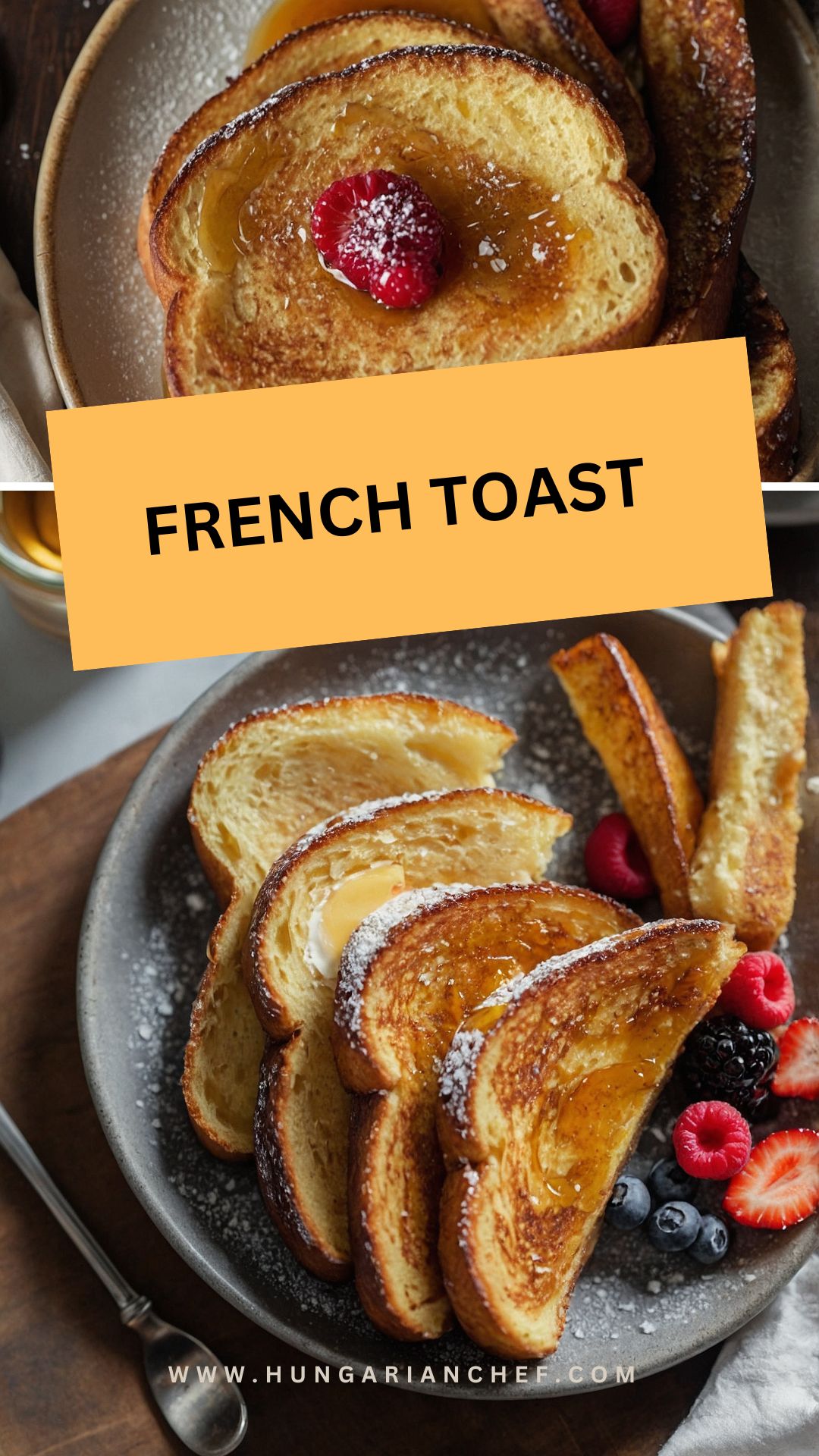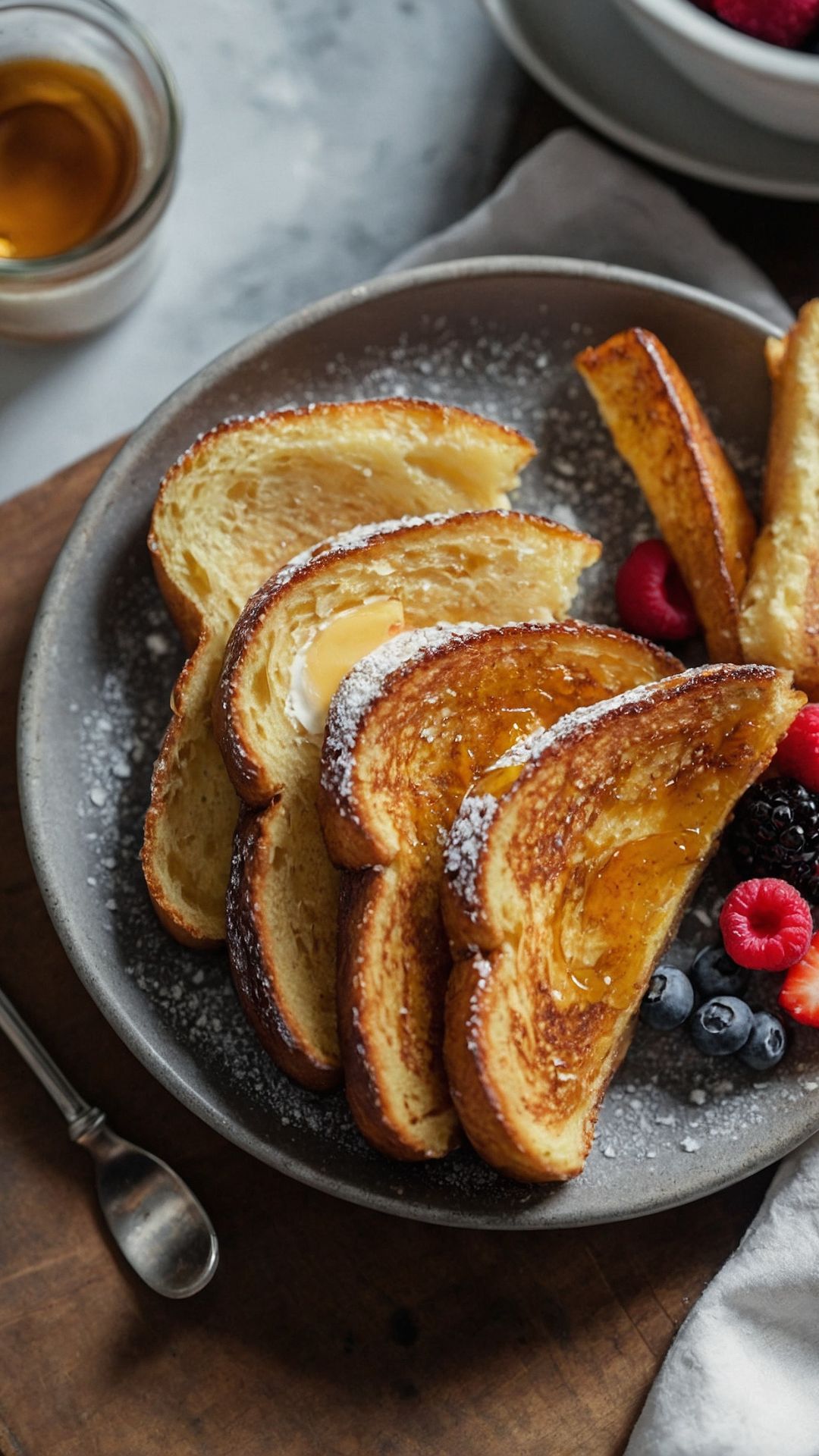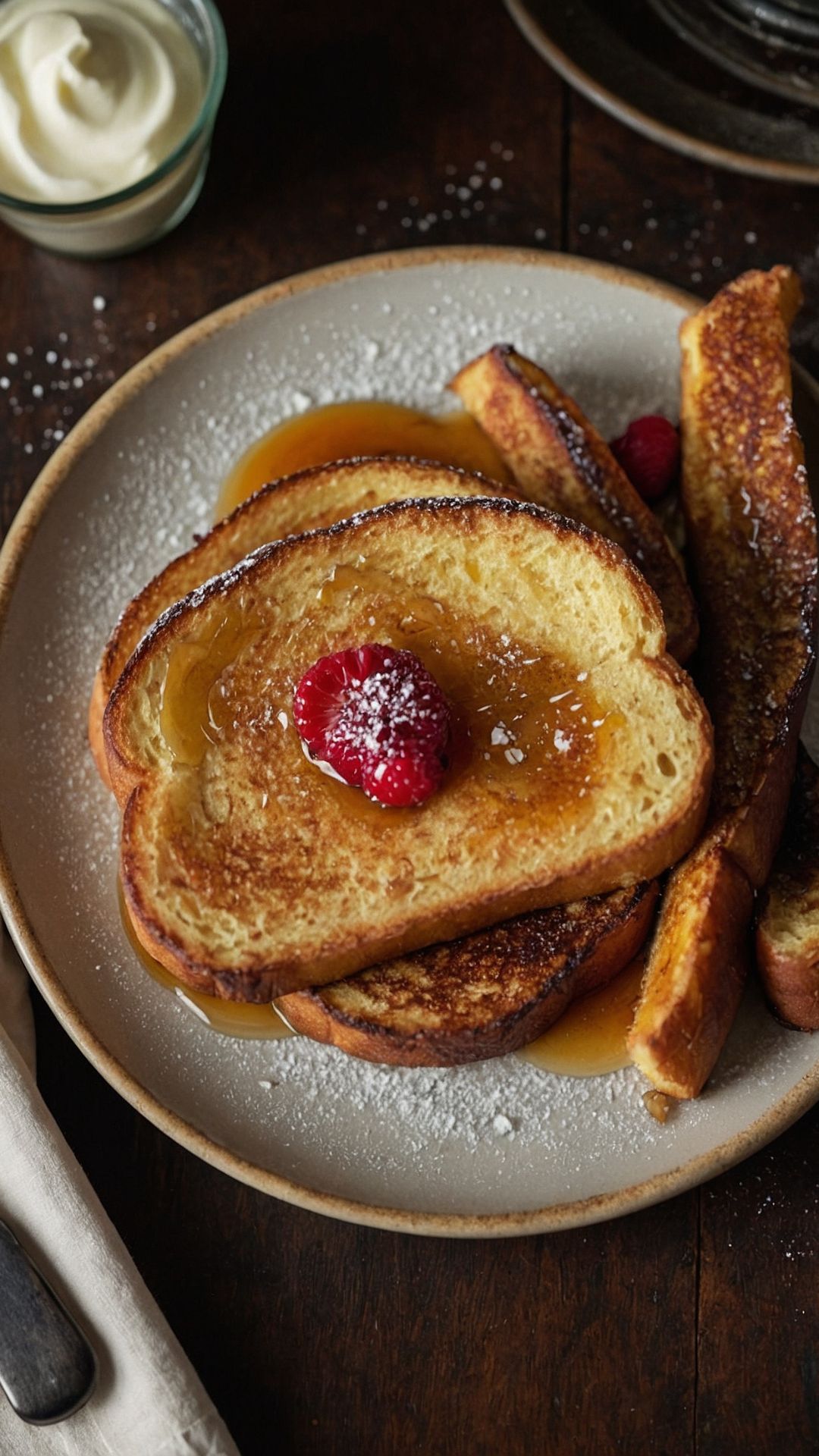When I think of delightful breakfast or brunch dishes, French toast undoubtedly tops the list. It’s soft, sweet, and incredibly versatile. Now, while French toast is fantastic on its own, pairing it with the right accompaniments can elevate the experience. Here are some suggestions that go delightfully well with French toast:
- Fresh Fruit: Berries like strawberries, blueberries, or raspberries add a refreshing burst of flavor. The natural sweetness and slight tartness contrast beautifully with the richness of the toast.
- Maple Syrup: A classic choice, pure maple syrup drizzled on top brings a sugary goodness that is hard to resist.
- Whipped Cream: Light and fluffy whipped cream can add an extra layer of indulgence.
- Yogurt: A dollop of Greek yogurt adds creaminess and is a tangy counterpoint to the sweetness.
- Nuts: Chopped pecans or walnuts introduce a satisfying crunch, adding both texture and flavor.

Let’s get one thing out of the way: French toast is not just a breakfast item; it’s an experience. There’s a certain magic in dipping thick slices of bread in a rich custard, tossing them onto a hot griddle, and watching as they transform into a golden-brown delight. It’s a dish that sparks joy, whether you’re serving it on a lazy weekend morning or impressing guests at a brunch gathering.
I still remember the first time I made French toast. I was in college, trying to impress my friends with my “culinary skills.” Armed with stale bread, eggs, and a dash of cinnamon, I created a breakfast that was met with nods of approval and satisfied murmurs. Since then, French toast has become a staple in my kitchen, a recipe that I’ve honed over the years.
What is French Toast?
French toast, or “pain perdu” as it is called in France, is a simple yet satisfying dish made by soaking slices of bread in a mixture of eggs, milk, and flavorings such as vanilla and cinnamon. The bread is then cooked on a griddle until golden.
Originally born as a dish to avoid wasting stale bread, French toast has evolved into a beloved breakfast across various cultures. Notably, it’s known for its flexibility. You can customize it with a variety of toppings, sauces, or add-ins, making it as unique as you are.
Why You’ll Love This French Toast Recipe
This French toast recipe is not only easy to prepare but also incredibly satisfying. Here are the reasons you’ll fall in love with it:
- Simplicity: With just a handful of ingredients, this recipe is straightforward yet delivers fabulous results.
- Flavorful Base: The combination of cinnamon, nutmeg, and vanilla elevates the flavor profile. It’s like a warm hug in food form.
- Texture: The result is perfectly crisp on the outside but soft and custardy on the inside, creating a delightful eating experience.
- Versatility: You can dress it up with your favorite toppings or keep it simple. The sky’s the limit!
- Make Ahead: If you’re hosting, this dish can be prepared ahead of time, saving you precious moments on the day of your gathering.
You will also like the following Breakfast recipes!
- Healthy Pumpkin Oatmeal Pancakes
- Copycat Homemade Healthy Sandwich Bread
- 5 Ingredient Almond Flour Pancakes Recipe
The Ingredients You Will Need To Make French Toast Recipe
Here’s what you’ll need:
- 8 Thick-Cut Bread Slices: You want them slightly stale or toasted for the best texture.
- ¼ Teaspoon Sea Salt: Enhances the flavor.
- 1 Tablespoon Melted Butter: Adds richness to the custard.
- 4 Large Eggs: The base for the custard.
- ¼ Teaspoon Ground Nutmeg: A warm hint of spice.
- ¼ Cup Plain Flour (30 g): For a smooth custard base.
- ⅔ Cup Whole Milk (160 ml): Ensures a creamy consistency.
- 1 Teaspoon Pure Vanilla Extract (5 ml): For fragrance and flavor.
- ¼ Cup Fine White Sugar (50 g): Balances the sweetness.
- ¾ Teaspoon Ground Cinnamon: For warmth and spice.

Directions
Step 1: Prepare the Custard Mixture
In a large mixing bowl, whisk the four large eggs together until they are broken down. Then add in the milk, melted butter, vanilla extract, and sugar. Sprinkle in the ground cinnamon, nutmeg, and a pinch of sea salt. Use a whisk to blend everything together until it’s smooth.
Step 2: Choose Your Bread
Choose a bread that holds up well to soaking. I prefer thick-cut brioche or challah. If you’ve got stale bread, it’s the perfect time to pull it out. Stale bread absorbs the custard without falling apart.
Step 3: Soak the Bread
Dunk each slice of bread into the custard mixture, ensuring it’s coated evenly. Don’t rush! Let it soak for about 30 seconds to a minute on each side. This allows it to fully absorb the flavors. You want it to be soaked but not too soggy!
Step 4: Heat the Griddle
Heat a non-stick skillet or griddle over medium heat. If not using a non-stick surface, add a little butter to prevent sticking. Once hot, place the soaked bread slices onto the skillet.
Step 5: Cook
Cook the bread for about 3 to 4 minutes on each side. You’re looking for a golden-brown color. Adjust the heat as necessary if the bread is browning too quickly.
Step 6: Serve
Once cooked, serve the French toast immediately. Top it with your favorite condiments, whether that’s maple syrup, fresh fruit, whipped cream, or a sprinkle of powdered sugar.
Notes
- Use Stale Bread: Stale bread is preferred for best results. Fresh bread can become too soggy.
- Don’t Rush the Soak: Allowing the bread to properly soak makes a noticeable difference in texture.
- Cooking Temperature: Maintain a steady medium heat. If it’s too hot, you will get burnt toast.
- Make It Ahead: Assemble your custard the night before and soak your bread before breakfast. Cook it fresh in the morning.
- Variations: Experiment with different spices, such as cardamom or ginger, to create unique flavors that suit your taste.
Storage Tips
- Refrigerate: If you have leftovers, store them in an airtight container in the fridge for up to 2 days.
- Reheat: When reheating, a toaster or an oven works best to maintain that crispiness.
Nutrition Information
A serving of this French toast contains approximately:
- Calories: 250
- Protein: 8g
- Carbohydrates: 35g
- Fat: 10g
- Sugar: 8g

Serving Suggestions
- Top with Fresh Berries: The tartness and freshness create a delightful contrast.
- Drizzle Maple Syrup: A classic pairing, nothing beats the sweetness of pure maple syrup.
- Add Sliced Bananas with Nutella: The chocolate-hazelnut spread with bananas is heavenly.
- Serve with Yogurt: A scoop of yogurt adds creaminess and cuts through the sweetness.
- Finish with a Dust of Powdered Sugar: A light dusting makes everything look more fabulous.
What Other Substitutes Can You Use in French Toast Recipe?
If you want to switch things up, consider these alternatives:
- Alternative Breads: Use sourdough, gluten-free bread, or ciabatta for different flavors and textures.
- Milk Alternatives: Almond milk, oat milk, or coconut milk can easily replace the dairy without sacrificing taste.
- Sweeteners: Honey, maple syrup, or agave syrup can substitute for regular sugar.
- Egg Replacements: For a vegan version, try mashed bananas, unsweetened applesauce, or a commercial egg replacer.
- Flavor Enhancements: Use extracts like almond or coconut instead of vanilla for a different twist.

Equipment
- Skillet
Ingredients
- 8 Thick-Cut Bread Slices: You want them slightly stale or toasted for the best texture.
- ¼ Teaspoon Sea Salt: Enhances the flavor.
- 1 Tablespoon Melted Butter: Adds richness to the custard.
- 4 Large Eggs: The base for the custard.
- ¼ Teaspoon Ground Nutmeg: A warm hint of spice.
- ¼ Cup Plain Flour 30 g: For a smooth custard base.
- ⅔ Cup Whole Milk 160 ml: Ensures a creamy consistency.
- 1 Teaspoon Pure Vanilla Extract 5 ml: For fragrance and flavor.
- ¼ Cup Fine White Sugar 50 g: Balances the sweetness.
- ¾ Teaspoon Ground Cinnamon: For warmth and spice.
Instructions
Step 1: Prepare the Custard Mixture
- In a large mixing bowl, whisk the four large eggs together until they are broken down. Then add in the milk, melted butter, vanilla extract, and sugar. Sprinkle in the ground cinnamon, nutmeg, and a pinch of sea salt. Use a whisk to blend everything together until it’s smooth.
Step 2: Choose Your Bread
- Choose a bread that holds up well to soaking. I prefer thick-cut brioche or challah. If you’ve got stale bread, it’s the perfect time to pull it out. Stale bread absorbs the custard without falling apart.
Step 3: Soak the Bread
- Dunk each slice of bread into the custard mixture, ensuring it’s coated evenly. Don’t rush! Let it soak for about 30 seconds to a minute on each side. This allows it to fully absorb the flavors. You want it to be soaked but not too soggy!
Step 4: Heat the Griddle
- Heat a non-stick skillet or griddle over medium heat. If not using a non-stick surface, add a little butter to prevent sticking. Once hot, place the soaked bread slices onto the skillet.
Step 5: Cook
- Cook the bread for about 3 to 4 minutes on each side. You’re looking for a golden-brown color. Adjust the heat as necessary if the bread is browning too quickly.
Step 6: Serve
- Once cooked, serve the French toast immediately. Top it with your favorite condiments, whether that’s maple syrup, fresh fruit, whipped cream, or a sprinkle of powdered sugar.
Notes
- Use Stale Bread: Stale bread is preferred for best results. Fresh bread can become too soggy.
- Don’t Rush the Soak: Allowing the bread to properly soak makes a noticeable difference in texture.
- Cooking Temperature: Maintain a steady medium heat. If it’s too hot, you will get burnt toast.
- Make It Ahead: Assemble your custard the night before and soak your bread before breakfast. Cook it fresh in the morning.
- Variations: Experiment with different spices, such as cardamom or ginger, to create unique flavors that suit your taste.
Nutrition
Frequently Asked Questions
1. Can I make French toast without eggs?
Yes! You can use mashed bananas or a commercial egg substitute mixed with plant-based milk to create a custard-like mixture.
2. How can I make French toast healthier?
Make it healthier by using whole grain or gluten-free bread, reducing sugar, and serving with fresh fruit or yogurt instead of syrup.
3. Can I freeze French toast?
Absolutely! Once the French toast has cooled completely, wrap it individually in plastic wrap and place it in a freezer bag. It can last for up to 1 month.
4. What’s the best type of bread for French toast?
Breads like challah, brioche, or even French baguette work wonderfully because they are denser and soak up the custard nicely.
5. Is French toast a good option for meal prep?
Definitely! You can prepare the custard mixture in advance and soak your bread the night before. It makes mornings much easier!
6. Can I add flavors to the custard?
Yes! You can mix in spices like cardamom or add citrus zest for an exciting flavor twist.
Conclusion
French toast is truly a breakfast classic with endless possibilities. It’s more than just a dish; it’s a canvas for creativity and comfort. With this recipe in hand, you’re armed to create the perfect French toast that can be customized to suit your palate.
Whether you opt for a simpler approach or dress it up for company, the result is always a delightful experience. So fire up that griddle, grab your favorite toppings, and indulge in the joy of homemade French toast. Trust me, once you’ve made this dish, it will become a favorite in your household. Enjoy!
You’ll also like these latest recipes!
- One Pan Tomato Basil Baked Orzo Recipe
- How to make Chaffles
- Healing Thai Butternut Squash Lentil Soup

Rebecca Novak is a trained chef with over 10 years of experience in the food industry. She has worked in both fine dining and casual Hungarian restaurants and specializes in creating dishes using fresh, seasonal ingredients. She also loves exploring different cuisines worldwide, which allows her to bring unique flavors and ideas to the recipes she creates for Hungarianchef.com. Read more
